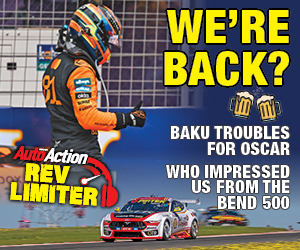SUPERCARS – A SEASON OF CHALLENGES

By Bruce Williams
Date posted: 24 December 2020

Supercars – A season of challenges – Image: LAT
A major feature of AUTO ACTION’S bumper 72-page Christmas issue is a comprehensive review of the Supercars Championship featuring expert analysis on a remarkable campaign.
Here is a preview of Mark Fogarty’s round-up of proceedings:
In a season unlike any other, one thing didn’t change: Scott McLaughlin’s domination. His title defence wasn’t as easy as last year – and it certainly wasn’t as controversial – but his supremacy was never in doubt.
McLaughlin left Australia for an IndyCar future with Team Penske after winning his third straight V8 crown – just one of four champions in ATCC/Supercars history to achieve a three-peat, joining Ian Geoghegan, Mark Skaife and Jamie Whincup.
If the Aussie-raised Kiwi stuck around, the four-in-a-row record (Geoghegan), five titles mark (Dick Johnson and Skaife) or even Whincup’s all-time top seven titles would have been met or exceeded.
Who knows, Scotty may come back one day to add to his Supercars championship score.
As it was, he left an imposing legacy in 2020 alone. A near-record 15 pole positions and 13 race wins, plus an unusually large 451 points margin over Cam Waters in the championship.
To put McLaughlin’s dominance into perspective, he won half of all available poles – the total score of the other eight combined – and more than doubled next best Whincup’s six No.1 starts. He won close to half of the 30 races – and more than three times the strike rate of closest rivals Whincup and Shane van Gisbergen (four each).
Once again, Scotty, his Shell V-Power Racing Team Ford Mustang and DJR team Penske was the best driver/car/team combination by far. And they did it without rancour or resistance.
The off-season aero adjustment trimmed the disfigured Mustang’s advantage, bringing the ZB Commodore right back into play. And yet, Triple Eight was unable to capitalise on the newly level playing field, wrong footing themselves throughout the compressed, rapid-fire season.
On top of all the logistical dramas, the post-season was shaken, if not stirred, by the (expected) revelations that Roger Penske was withdrawing and Scotty was off to the States.
Losing the imprimatur of global racing and business deity Penske is a blow to Supercars’ international standing, while McLaughlin’s departure removes its biggest active star.

But if Supercars did nothing else in this oddest of all years, it proved it is adaptable and open to change. V8 racing arguably did a better job of coping with COVID-19 restrictions than the AFL and NRL.
Supercars completed an effective full championship in about four months without in-season scandal over hub breaches.
It cost the administration and the teams many, many millions of dollars, but together they got it done and ensured the series will survive to see better days.
Supercars changed race formats, went with back-to-back events at available and willing venues, and imposed cost-saving technical constraints that made the racing closer, if not more exciting.
It all proved that Supercars could throw off convention, which hopefully is a lesson for the future with or without COVID constrictions.
Amid the crisis, a new five-year broadcasting deal with Fox Sports and Seven was secured, plus Repco backing of the championship and the Bathurst 1000.
Supercars’ leadership often much (and justifiably) criticised, was innovative, flexible and exemplary, working in co-operation with Motorsport Australia more closely than perhaps ever before.
Never before was it better and more informative to watch the series on Fox Sports, which I did for the rest of the year after being at the Adelaide 500. The Supercars Media broadcast team did an heroic job to maintain such a high standard of coverage.
It’s such a pity some of the most credible staples of the commentary team will be missing next year…
The other big advance amid all the uncertainty was the announcement of the framework for Gen3 – the next generation of Supercars racers from 2022.
Cheaper, simpler, aesthetically faithful to the Mustang and Chevrolet Camaro, what’s not to like?
Fingers crossed that Gen3, unlike 2013’s Car Of The Future, actually makes V8 racing more viable and attractive to new manufacturers.
To read the full six-page preview featuring analysis from Supercars commentators Craig Lowndes and Andrew Jones as well from AA’s own Bruce Newton, pick up Auto Action #1801 online or at your local news outlet now!
Also make sure you follow us on social media Facebook, Twitter, Instagram or our weekly email newsletter for all the latest updates between issues.
Recent Stories
array (
0 =>
WP_Term::__set_state(array(
'term_id' => 6,
'name' => 'Features',
'slug' => 'features',
'term_group' => 0,
'term_taxonomy_id' => 6,
'taxonomy' => 'category',
'description' => 'AA looks beyond the news',
'parent' => 0,
'count' => 291,
'filter' => 'raw',
'cat_ID' => 6,
'category_count' => 291,
'category_description' => 'AA looks beyond the news',
'cat_name' => 'Features',
'category_nicename' => 'features',
'category_parent' => 0,
)),
1 =>
WP_Term::__set_state(array(
'term_id' => 11,
'name' => 'Latest News',
'slug' => 'latest-news',
'term_group' => 0,
'term_taxonomy_id' => 11,
'taxonomy' => 'category',
'description' => '',
'parent' => 0,
'count' => 16853,
'filter' => 'raw',
'cat_ID' => 11,
'category_count' => 16853,
'category_description' => '',
'cat_name' => 'Latest News',
'category_nicename' => 'latest-news',
'category_parent' => 0,
)),
2 =>
WP_Term::__set_state(array(
'term_id' => 38,
'name' => 'Supercars',
'slug' => 'supercars',
'term_group' => 0,
'term_taxonomy_id' => 38,
'taxonomy' => 'category',
'description' => 'The Supercars Championship, currently known as the Repco Supercars Championship, is the premier motorsport category in Australasia and one of Australia\'s biggest sports. It originated from the Australian Touring Car Championship (ATCC), which held its first race in 1960 at Gnoo-Blas in Orange, New South Wales. The ATCC evolved over the years, and in 1997, it was rebranded as the V8 Supercars Championship, eventually becoming the Supercars Championship we know today.
Some of the leading drivers in the history of the Supercars Championship include Peter Brock, who is often referred to as the "King of the Mountain" for his nine victories at the Bathurst 1000, a race that is considered one of the biggest in the series. Other notable drivers include Dick Johnson, Marcos Ambrose, Craig Lowndes, Shane van Gisbergen, Jamie Whincup, who holds the record for the most championship titles, and Mark Skaife, who has also been a dominant force in the series.
The Bathurst 1000, held at Mount Panorama Circuit in Bathurst, New South Wales, is arguably the most famous race in the Supercars calendar. Other significant races include the Sandown 500 and the Adelaide 500, which are known for their challenging circuits and thrilling competitions.
The Supercars Championship has grown to become a globally recognized series, known for its competitive racing and passionate fan base. It continues to be a major part of Australia\'s motorsport culture, attracting top drivers and teams from around the world.',
'parent' => 0,
'count' => 5651,
'filter' => 'raw',
'cat_ID' => 38,
'category_count' => 5651,
'category_description' => 'The Supercars Championship, currently known as the Repco Supercars Championship, is the premier motorsport category in Australasia and one of Australia\'s biggest sports. It originated from the Australian Touring Car Championship (ATCC), which held its first race in 1960 at Gnoo-Blas in Orange, New South Wales. The ATCC evolved over the years, and in 1997, it was rebranded as the V8 Supercars Championship, eventually becoming the Supercars Championship we know today.
Some of the leading drivers in the history of the Supercars Championship include Peter Brock, who is often referred to as the "King of the Mountain" for his nine victories at the Bathurst 1000, a race that is considered one of the biggest in the series. Other notable drivers include Dick Johnson, Marcos Ambrose, Craig Lowndes, Shane van Gisbergen, Jamie Whincup, who holds the record for the most championship titles, and Mark Skaife, who has also been a dominant force in the series.
The Bathurst 1000, held at Mount Panorama Circuit in Bathurst, New South Wales, is arguably the most famous race in the Supercars calendar. Other significant races include the Sandown 500 and the Adelaide 500, which are known for their challenging circuits and thrilling competitions.
The Supercars Championship has grown to become a globally recognized series, known for its competitive racing and passionate fan base. It continues to be a major part of Australia\'s motorsport culture, attracting top drivers and teams from around the world.',
'cat_name' => 'Supercars',
'category_nicename' => 'supercars',
'category_parent' => 0,
)),
)








